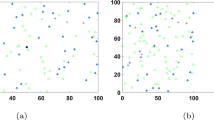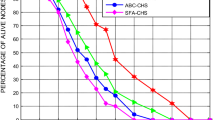Abstract
Wireless Sensor Networks are essential for monitoring physical objects in smart systems powered by the Internet of Things. It gathers information by detecting the surroundings and transmits it to a central repository. In this study, an unknown domain was explored using multi-objective optimization. This proposed work employs Multi-objective Grey Wolf Optimization to form effective clustering among nodes and also for choosing the cluster head. Based on the multi-objective fitness function, the cluster heads are selected. For every iteration, the cluster heads are changed thereby saving the consumption of energy and also resulting in an increase in network lifespan. The suggested method divides the network into various optimal-sized clusters and chooses the best cluster heads. The performance of the multi-objective exploration is presented. The proposed method`s key contributions are by utilizing MOGWO for efficient clustering and CH selection, ultimately enhancing network performance. It dynamically adjusts CHs, resulting in energy savings and an extended network lifespan. MOGWO takes into account multiple objectives simultaneously. Through network configuration optimization, MOGWO enhances resource utilization, resulting in lower energy consumption, extended network lifetime, and improved overall efficiency.







Similar content being viewed by others
References
Khalaf, O. I., & Sabbar, B. M. (2019). An overview on wireless sensor networks and finding optimal location of nodes. Periodicals of Engineering and Natural Sciences (PEN), 7(3), 1096–1101.
El Alami, H., & Najid, A. (2019). ECH: An enhanced clustering hierarchy approach to maximize lifetime of wireless sensor networks. IEEE Access, 7(1–1), 107142–107153.
Ketshabetswe, L. K., Zungeru, A. M., Mangwala, M., Chuma, J. M., & Sigweni, B. (2019). Communication protocols for wireless sensor networks: A survey and comparison. Heliyon, 5(5), 1–43.
Khediri, S. E., Fakhet, W., Moulahi, T., Khan, R., Thaljaoui, A., & Kachouri, A. (2020). Improved node localization using K-means clustering for wireless sensor networks. Computer Science Review, 37(3), 100284.
Shi, J., & Sha, M. (2019). Parameter self-configuration and self-adaptation in industrial wireless sensor-actuator networks. IEEE INFOCOM 2019-IEEE conference on computer communications, pp 658–666, 10.1109/ INFOCOM.2019.8737467.
Arora, A., & Zhang, H. (2006). LSRP: Local stabilization in shortest path routing. IEEE/ACM Transactions on Networking, 14(3), 520–531.
Lee, H., Ryu, J., Kim, K., & Han, K. (2006). A density based self-configuration scheme in wireless sensor networks. Advanced web and network technologies, and applications, lecture notes in computer science, 3842, 350–359, https://doi.org/10.1007/11610496_47
Wan, J., Chen, W., Xu, X., & Fang, M. (2008). An efficient self-healing scheme for wireless sensor networks. International conference on future generation communication and networking, 1 https://doi.org/10.1109/FGCN. 2008.138
Li, N., Liu, Y., Shi, Q., Wang, S., & Zou, K. (2021). Multi objective particle swarm optimization based on cosine distance mechanism and game strategy. Computational Intelligence and Neuroscience, 2021, 1–19.
Sun, Y., & Gao, Y. (2019). A multi-objective particle swarm optimization algorithm based on gaussian mutation and an improved learning strategy. Mathematics, 7(2), 1–16.
Zhou, A., Qu, B. Y., Li, H., Zhao, S. Z., Suganthan, P. N., & Zhang, Q. (2011). Multi objective evolutionary algorithms: A survey of the state of the art. Swarm and Evolutionary Computation, 1(1), 32–49.
Parsopoulos, K.E., & Vrahatis, M.N. (2002). Particle swarm optimization method in multi objective problems. In: Proceedings of the 2002 ACM symposium on applied computing, pp 603–607.
Zhang, Y., Cheng, S., Shi, Y., Gong, D. W., & Zhao, X. (2019). Cost-sensitive feature selection using two-archive multi-objective artificial bee colony algorithm. Expert System with Applications, 137(4), 46–58.
Lin, J., Ding, X., Li, H., & Zhou, J. (2020). Bilevel programming model and algorithms for flight gate assignment problem. The Aeronautical Journal, 124(1281), 1667–1682.
Kolak, O. I., Feyzioglu, O., & Noyan, N. (2018). Bi-level multi-objective traffic network optimisation with sustainability perspective. Expert System with Applications, 104, 294–308.
NavinDhinnesh, A. D. C., & Sabapathi, T. (2022). Probabilistic neural network based efficient bandwidth allocation in wireless sensor networks. J Ambient Intell Human Comput., 13, 2001–2012. https://doi.org/10.1007/s12652-021-02961-z
Dhinnesh, A. D. C. N., & Sundareswaran, N. (2022). An efficient self-healing network through quadratic probing optimization mechanism. International Journal of Communication Systems, 35(7), e5098. https://doi.org/10.1002/dac.5098
Xiwang, G., Zhiwei, Z., Liang, Q., Shixin, L., Ying, T., & Ziyan, Z. (2022). Stochastic hybrid discrete grey wolf optimizer for multi-objective disassembly sequencing and line balancing planning in disassembling multiple products. IEEE Transactions on Automation Science and Engineering., 19, 3.
Nur, L. S. A., & Helmi, M. D. R. (2022). Population initialization factor in binary multi-objective grey wolf optimization for features selection. IEEE Access., 10, 114942–114958.
Sayed, M. H., Amir, S., Amir, M. R., & Mahdi, B. (2022). GWO-SA: Gray wolf optimization algorithm for service activation management in fog computing. IEEE Access., 10, 107846–107863.
Muhammad, I. A., Syed, A. A. K., Omar, A., Zafar, A. K., Abdullah, A., & Malik, M. M. (2022). A novel hybrid optimization-based algorithm for the single and multi-objective achievement with optimal dg allocations in distribution Networks. IEEE Power & Energy Society Section. IEEE Access, 10, 25669–25687.
Nima, K., Laith, A., El-Sayed, M.-K., Vaclav, S., & Seyedali, M. (2022). An archive-based multi-objective arithmetic optimization algorithm for solving industrial engineering problems. IEEE Access, 10, 106673–106698.
Asad, A., Farhan, A., Muhammad, F. K., Muazzam, M., & Sangsoon, L. (2023). Harris hawks optimization-based clustering algorithm for vehicular Ad-Hoc networks. IEEE Transactions on Intelligent Transportation Systems., 24, 6.
Jannat, U. A. B. W. A., Syed, A. A. K., Abdullah, A., Zafar, A. K., Omar, A., & Muhammad, M. M. (2022). Smart energy management in virtual power plant paradigm with a new improved multilevel optimization based approach. IEEE Access., 10, 50062–50077.
Jeffrey, O. A., Absalom, E. E., & Laith, A. (2023). Gazelle optimization algorithm: A novel nature-inspired metaheuristic optimizer. Neural Computing and Applications, 35, 4099–4131.
Gang, H., Yixuan, Z., Laith, A., & Abdelazim, G. H. (2023). DETDO: An adaptive hybrid dandelion optimizer for engineering optimization. Advanced Engineering Informatics, 57, 1–36.
Zare, M., Ghasemi, M., Zahedi, A., et al. (2023). A global best-guided firefly algorithm for engineering problems. Journal of Bionic Engineering., 20, 2359–2388.
Laith, A., Serdar, E., Davut, I., & Raed, A. Z. (2023). Modified elite opposition-based artificial hummingbird algorithm for designing FOPID controlled cruise control system. Intelligent Automation and Soft Computing. https://doi.org/10.32604/iasc.2023.040291
Ezugwu, A. E., Agushaka, J. O., Abualigah, L., et al. (2022). Prairie dog optimization algorithm. Neural Computing & Applications., 34, 20017–20065.
Jeffrey, O. A., Absalom, E. E., & Laith, A. (2022). Dwarf mongoose optimization algorithm. Computer Methods in Applied Mechanics and Engineering., 391, 1–38.
Ahmadi, R., Ekbatanifard, G., & Bayat, P. (2021). A modified grey wolf optimizer based data clustering algorithm. Applied Artificial Intelligence, 35(1), 63–79.
Ojha, A., & Chanak, P. (2021). Multi-objective gray wolf optimization-based data routing scheme for wireless sensor networks. IEEE Internet of Things Journal, 9(6), 4615–4623. https://doi.org/10.1109/JIOT.2021.3105425
Albina, K., Sergey, N., Dianwei, Q., & Suk, G. L. (2019). Multi-robot exploration based on multi-objective grey wolf optimizer. Applied Sciences, 9, 1–16.
Acknowledgements
The authors acknowledge the support and encouragement given by the Management, Principal, Director of Computer Applications, Senior Professor and Head, Department of Electronics and Communication Engineering, toward this work
Author information
Authors and Affiliations
Corresponding author
Ethics declarations
Conflict of interest
The authors have no relevant financial or non-financial interests to disclose.
Additional information
Publisher's Note
Springer Nature remains neutral with regard to jurisdictional claims in published maps and institutional affiliations.
Rights and permissions
Springer Nature or its licensor (e.g. a society or other partner) holds exclusive rights to this article under a publishing agreement with the author(s) or other rightsholder(s); author self-archiving of the accepted manuscript version of this article is solely governed by the terms of such publishing agreement and applicable law.
About this article
Cite this article
Navin Dhinnesh, A.D.C., Sabapathi, T. Multi-objective Grey Wolf Optimization based self configuring wireless sensor network. Wireless Netw (2024). https://doi.org/10.1007/s11276-024-03732-2
Accepted:
Published:
DOI: https://doi.org/10.1007/s11276-024-03732-2




